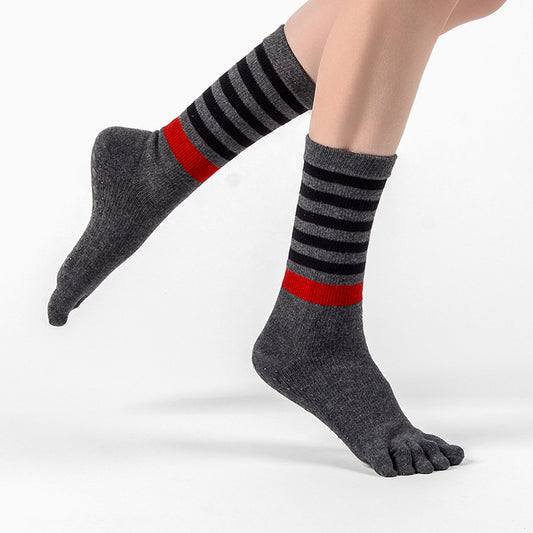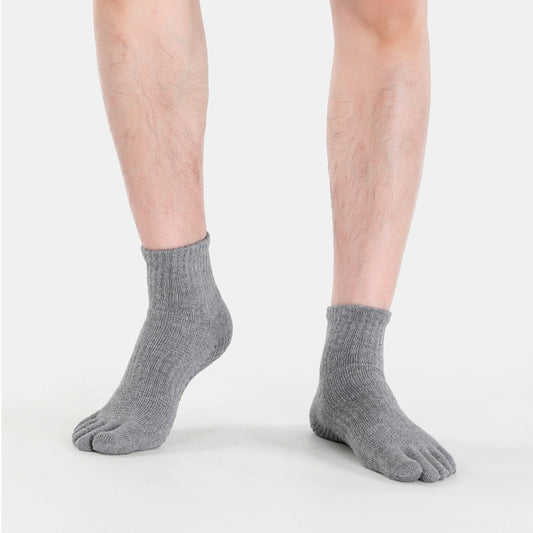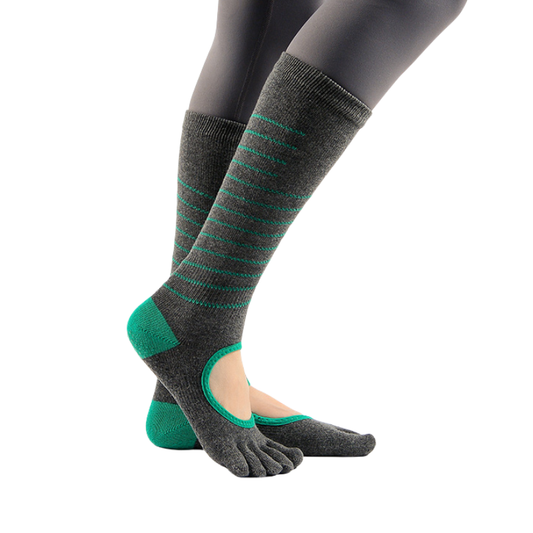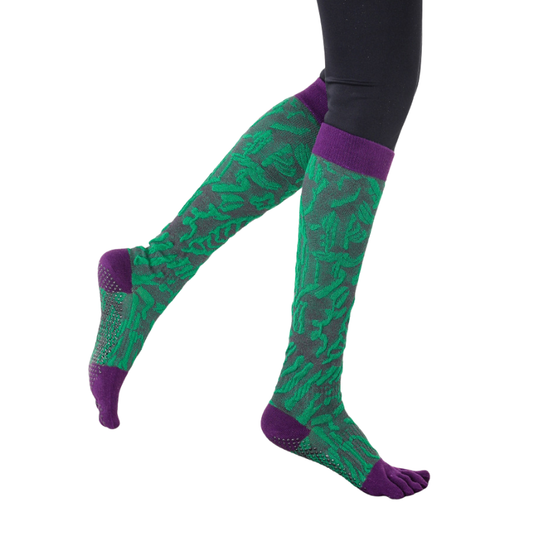Grip socks—also known as non-slip socks—have become a staple for anyone practicing yoga, Pilates, barre, or any fitness activity where traction and foot control are key. While grip pattern design often takes the spotlight, the material composition of your socks plays an equally vital role in comfort, durability, and overall performance.
But when it comes to choosing between cotton and synthetic materials, which performs better?
Let’s dive into the science and real-world usage to help you make the best choice for your feet.
Why Material Matters in Grip Socks
The right grip sock should:
-
Wick away moisture efficiently
-
Provide consistent traction
-
Resist odor and bacterial buildup
-
Fit snugly without slipping
-
Be comfortable for extended wear
Each material brings its own strengths and trade-offs in achieving these goals.
Cotton Grip Socks: Comfort at a Cost
Cotton is beloved for its natural softness and breathability. It’s often recommended for sensitive skin or those who prioritize comfort over technical performance.
Pros:
-
Soft and breathable – great for low-impact use or lounging
-
Hypoallergenic – ideal for sensitive skin
-
Eco-friendly and biodegradable
-
Affordable and easy to wash
Cons:
-
Retains moisture, increasing the risk of blisters and fungal infections
-
Slower to dry, especially after sweaty sessions
-
Loses shape more quickly than synthetics
-
Less durable over time
According to podiatrist-approved guides from Health.com, cotton socks are a double-edged sword: while they’re gentle, they absorb and retain sweat, which can be detrimental during high-sweat activities.
Synthetic Grip Socks: Built for Performance
Synthetic materials such as polyester, nylon, and spandex are engineered for moisture control, shape retention, and grip consistency—especially under pressure.
Pros:
-
Superior moisture-wicking capabilities
-
Quick-drying and lightweight
-
Holds shape and compression better
-
More durable for intense workouts
-
Often treated with anti-odor or antimicrobial finishes
Cons:
-
May trap heat and feel less breathable
-
Can cause irritation for ultra-sensitive skin
-
Not biodegradable – environmental concerns apply
A study published by the National Center for Biotechnology Information (NCBI) confirms that synthetic fabrics outperform cotton in high-intensity environments due to their moisture regulation and durability.
Additionally, Self Magazine notes that athletes and fitness experts prefer synthetic blends for their ability to reduce foot odor and maintain grip traction.
Blended Materials: The Best of Both Worlds
Most premium grip socks today use a blend—often cotton mixed with polyester or nylon—to maximize comfort while ensuring technical performance. These hybrid fabrics:
-
Provide the softness of cotton
-
Retain moisture-wicking performance
-
Offer durability for active use
Material Impact on Grip Zones
Grip socks rely not just on the base fabric, but on how well the material supports grip adhesion—typically made of silicone or rubberized patterns. According to Hipswan, synthetic blends often form a better base for durable, high-friction grip zones.
In high-intensity classes, where sweat can break down adhesive grip quickly, synthetic bases provide better longevity and friction hold.
When Cotton Wins
Choose cotton-based grip socks when:
-
You’re doing light activities or recovery sessions
-
Comfort outweighs moisture control
-
You have extremely sensitive skin
-
You’re wearing socks indoors casually or for sleep
Cotton is still a popular choice in hospitals for post-surgical patients, thanks to its comfort and breathability.
When Synthetic Excels
Go for synthetic or synthetic-heavy blends when:
-
You’re practicing yoga, barre, or Pilates multiple times a week
-
You sweat heavily or are prone to odor
-
You need long-lasting elasticity and performance
-
You value fast-drying gear for travel or daily workouts
Fitness experts at ISSA Online also suggest that cotton-only options aren’t ideal for training environments because they compromise performance and hygiene.
Quick Comparison Table
| Feature | Cotton | Synthetic (Poly/Nylon) |
|---|---|---|
| Comfort | ★★★★★ | ★★★☆☆ |
| Moisture Wicking | ★★☆☆☆ | ★★★★★ |
| Durability | ★★☆☆☆ | ★★★★★ |
| Breathability | ★★★★☆ | ★★★☆☆ |
| Odor Resistance | ★★☆☆☆ | ★★★★☆ |
| Drying Time | Slow | Fast |
Final Verdict
So, which grip sock material performs better? If you’re prioritizing performance, moisture control, and long-term wear, synthetic or blended materials clearly have the edge. But if comfort, softness, and natural fibers are your top concerns, cotton might still earn a place in your sock drawer.
Most users will benefit from owning both types—selecting the right one based on activity intensity and personal preferences.
Zokfit’s Take on Materials
At Zokfit, we blend soft combed cotton with high-performance synthetic fibers to deliver the perfect balance of comfort, traction, and durability. Whether you're stretching into downward dog or powering through barre squats, our grip socks are engineered to move with you—securely.
Explore our anti-slip grip sock collection to find your fit.







